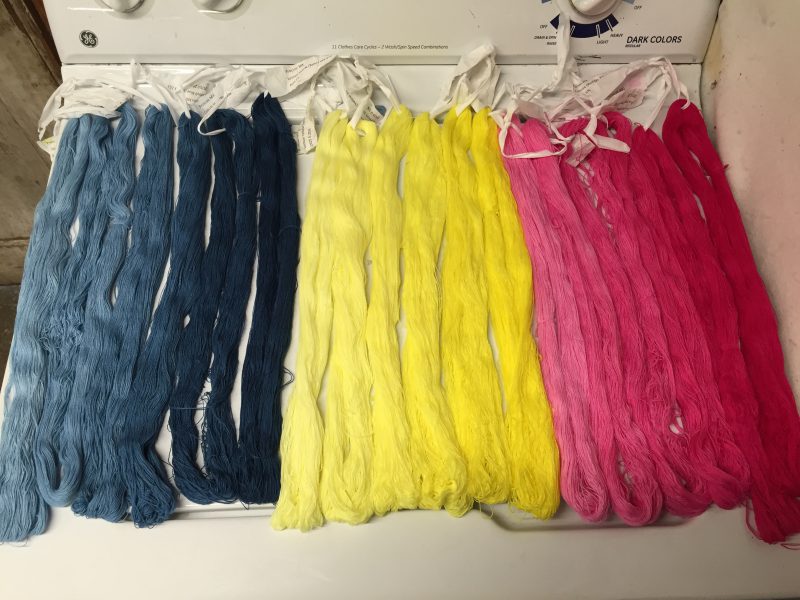One of the blessings of taking time off is that I can catch up on creative infrastructure projects. These projects provide the foundation for creative work, but are time-consuming and distinctly unglamorous. When I’m working full-time, they compete directly with time in the studio, so I generally don’t do them. But since I have more free time right now, I can tackle some of the bigger infrastructure projects: The studio reorganization, the website facelift, and now…dyeing 1100+ yarn samples to create a huge palette of fiber-reactive dyes on cotton.
Long-time blog readers may recall that, a few years ago, I spent an entire summer dyeing samples of silk using Lanaset acid dyes. This gave me a big color palette for acid dyes on silk. However, I seem to be moving more towards cotton, tencel, and other cellulose yarns, and I don’t have many samples for those colors. So I am starting to dye a palette for cotton, using fiber-reactive dyes. If I complete the full set that I’m envisioning, I should wind up with 1,134 samples. I’m going to use Procion MX dyes – while I prefer Cibacron F fiber-reactive dyes, the manufacturer recently discontinued one of the primary mixing colors, so it’s no longer viable for creating a wide color palette.
What samples am I dyeing? Well, first up is a set of six skeins each of fifteen colors, each at different concentrations of dye. Here is the first set – lemon yellow, fuchsia, and cobalt blue at DOS 0.25%, 0.5%, 1%, 2%, 4%, and 6%. I’m basically doubling the amount of dye between every pair of skeins, except for the last one which is only 1.5x the strength of the previous one.

I plan to dye 15 colors this way – the “pure” colors that I will mix together for the color samples, plus some premixed colors that I find handy.
After dyeing the single colors, I’m going to reduce the palette to two yellows, three reds, and three blues, and pick a specific concentration of dye to work with. And then I’m going to dye all possible combinations of those three sets, in increments of 10%, starting with two-color combinations and working my way up to all possible combinations of the yellow, red, and blue dyes.
Will I finish all 1,134 samples? Probably not. My plan is to continue until I feel I have a sufficiently large palette. This might take 500 samples, or 800, or the full 1,134. Samples are not cheap, time-wise, so I will stop working when I reach the point of diminishing returns. (Dyeing each set of 18 samples takes about three hours. If you do the math, you’ll see that the full set of samples will take about 190 hours, or about 5 weeks of full-time work. Not for the faint of heart!)
And have I forgotten about the loom in the rush of dye setup? No, I haven’t; I’m now about 2/3 done threading, and I expect to finish next week. I’m also starting to develop weave structures for the “Bipolar Prison” piece. And, finally, I’m continuing to think about what comes next in my life. (Yes, I’m saving time for that, too.)

I would suggest taking Carol Soderlund class the new color mixing for dyers. With a class in a week you complete over 1000 samples in a fab. system. It is a color theory as well. I think you would love it and her.
Thanks! I checked her site, and also emailed her.